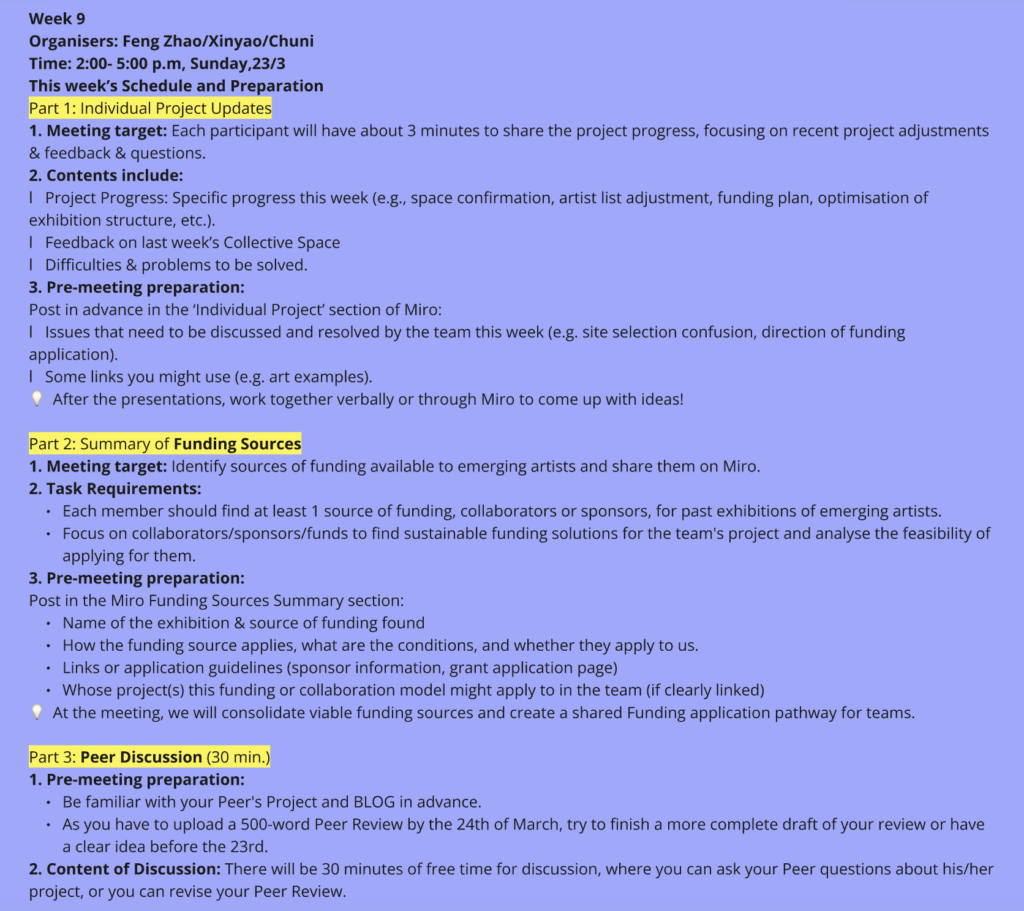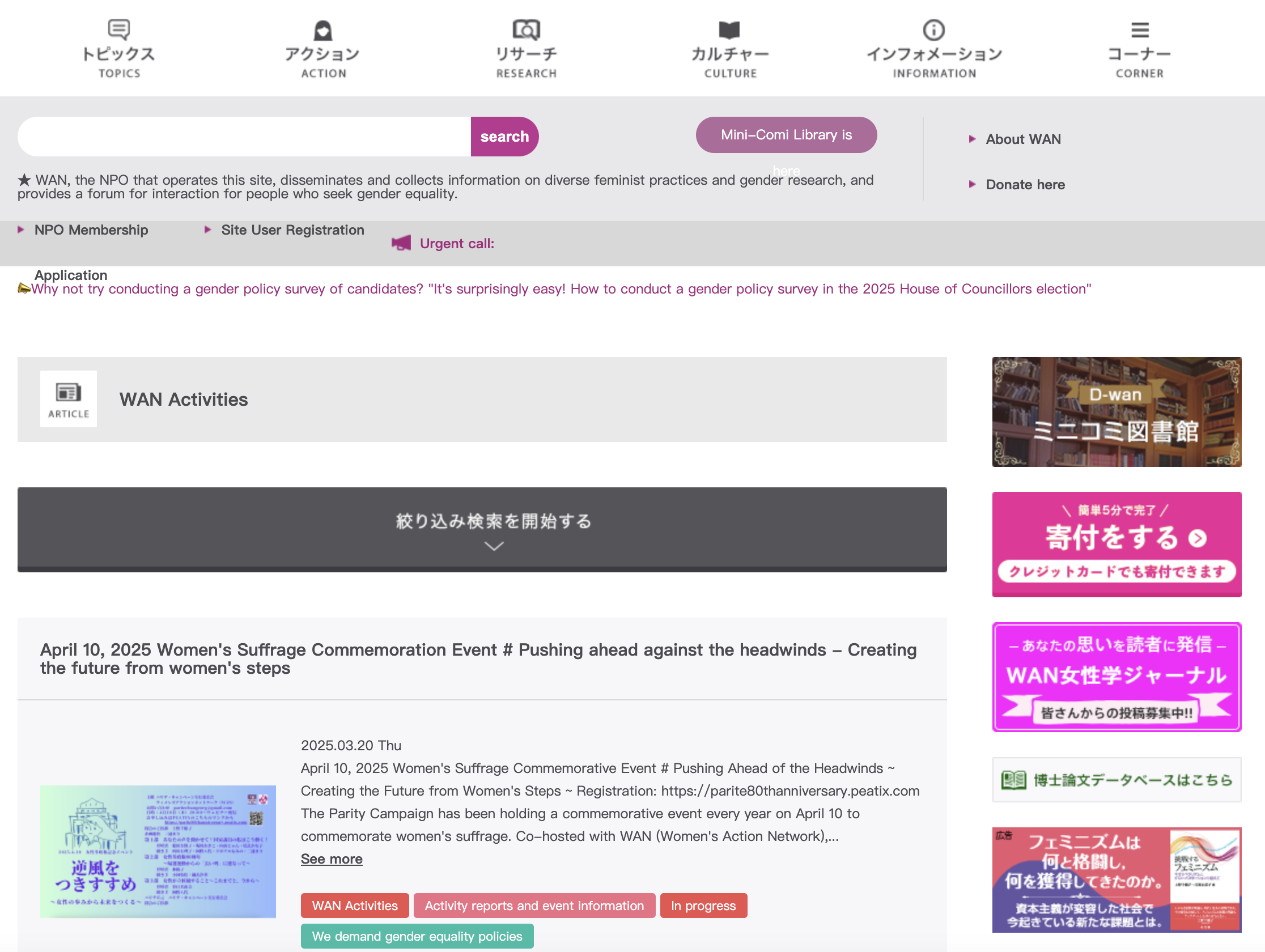The discussions across the two meetings formed the “internal and external perspectives” of my project’s development—shedding light on how to move the project from a conceptual framework to practical implementation.
On March 23, our Terra Obscura group meeting—organized by Feng Zhao, Xinyao, and Chuni—focused on sharing reflections on personal projects and discussing potential funding sources.

Meeting Process
Funding Sources: From resource search to structural confusion
In the second Collective Space meeting, my peers shared various funding sources. Although they introduced several potential channels—such as Creative Scotland, the Joan Mitchell Foundation, and the NHS Foundation—I noticed that most of these resources were concentrated in the UK and geared toward individual artist support (e.g., the Creative Scotland).
As my project is situated within the East Asian context, securing local funding emerged as a structural challenge that requires urgent attention. This also highlighted a significant disparity between curators and artists in terms of access to resources.
Expanded funding options for curatorial projects
The Tokyo Arts and Space Open Site project I chose provides basic funding (up to 500,000 yen). However, this amount is clearly insufficient for curatorial practices that go beyond basic needs—particularly those involving cross-regional collaboration with women’s organizations and the development of digital platforms.

Information about TOKAS’s Open Site
Therefore, I am considering the possibility of applying jointly with local partner organizations. For example, by collaborating with Japanese women’s groups such as the Women’s Action Network (WAN), I could apply for domestic funding programs that support social engagement or artistic activities. Framing the project from the perspectives of women’s rights and social practice could enhance its chances of being funded.

The Women’s Action Network (WAN) website
Additionally, I have identified a feasible funding opportunity that aligns well with my project:
Local Funding Option in Japan:
One potential source is the Japan Foundation’s International Exchange Fund. According to the official 2025 Program Guidelines, the Exhibitions Abroad Support Program is particularly suited to my project, which is to be realized at Tokyo Arts and Space and co-curated with women’s organizations across East Asia.
Funding Reference:
-
There is no specific upper funding limit.
-
In 2024, the maximum grant awarded was approximately 4 million yen (around £22,000).
-
On average, grants range from 500,000 yen to several million yen.

Group photo
Resources:
Creative Scotland: https://www.creativescotland.com/funding/funding-programmes/open-funding/open-fund-for-individuals
The Women’s Action Network (WAN):https://wan.or.jp/general/category/activity-of-wan
The Japan Foundation Programs: https://www.jpf.go.jp/e/program/index.html
The Japan Foundation‘s 2025 Program Guidelines: https://www.jpf.go.jp/e/program/dl/guidelines_e_2025.pdf


3 April 2025 at 13:53
Overall, your Blog has some new thoughtful, creative and critically engaged content Shumiao. Your summary and reflection on the field trip in Week 7 provides good critical contextualisation and weaves research from both course and independent sources together effectively, well done. You ask interesting questions in Week 8 “When the survival dilemmas of ‘East Asian women’ are placed within the white cube spaces of Western cities, does it unconsciously reproduce a colonial gaze? 2. Can I foster genuine cross-regional women’s solidarity through a hybrid model of online and offline curation?” Adding reference to this, quotes from curators working on similar topics, or articles (sociology, cultural studies, feminism etc) would add strength to the commentary. There is some very strong reflection on the project development informed by Marcus’ week 8 lecture and your own research on temporality. In addition you have clearly acted on the feedback in relation to the potential of community engagement, well done. It would be good to see this connected with the course themes of ethics, more reflection on publics and audience engagement, and additional feminist contextualisations of your topic. There is an intersectional aspect to address to: gender and culture in relation to time poverty. The heading ‘the logic of offline venue screening’ is a little unclear, consider rephrasing. You show thoroughness in your evaluation of possible spaces, I’d encourage you to reflect on the advantages of curating with themes (as distinct from other methods). I also want to check that the beauty regime is focused on time as that is your project focus? Could you potentially consider another title that evokes all these ways of draining/controlling the women’s body through time regimes. Where do they come from clock time, capitalist time, etc. You present a strong reflection on the Week 9 lecture by Adam and the ideas you offer for a collaborative publication are really engaging, well done. Consider the ethics of this (research on witnessing, visibility, community forming practices), how you would facilitate this (are there different degrees of involvement, some supported, others open and a ‘lighter touch’ for example?) How do these questions intersect with Gabi’s lecture on publics, and public programmes? Are there models that have informed your thinking? Your commentary on the Collective Space offers good outlines, however, consider how you enhance with reflections on the types of skills/collaborative practice that such self-organised activities offer. What does it mean to be part of Summerhall, in relation to its mission? Your layout is simple and effective, however your subheadings are a little long/over-descriptive, and give all key information about artworks (dimensions, year, materials etc). Also good to look into and include research on the practices you plan to include (curators’ writings on their work, their own words?)